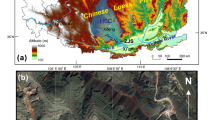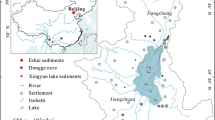Abstract
Shibanqiao Reservoir (25°56′56.5′′ N, 105°26′44.5′′ E and ∼1400 m a.s.l.), southwest Guizhou Plateau, SW China, was built in 1958. It lies in an area of sub-tropical monsoon humid climate in a carbonate-rock-dominated catchment of 6 km2. Two sediment cores (24 and 23 cm long) were retrieved from the reservoir, and four soil profiles were sampled in the catchment. Mineral magnetism was measured on all sediment and soil samples. Soil and sediment magnetic measurements together with analyses of sediment 137Cs activity, particle-size, TOC, and C/N revealed changes in soil erosion between 1960 and 2002. During some phases, erosion (probably as splashing and/or sheeting) was relatively low and tended to take place only in the topsoil as indicated by high ARM/SIRM of the sediments. During other phases, erosion (probably as rilling and/or initial gullying) was relatively intense and thus disturbed the deeper soils, as expressed by high IRM−100mT/SIRM. Most of the changes in relative intensity of erosion can be ascribed to fluctuations in precipitation. Changes in land use/land cover or human activities may account, in part, for changes in soil erosion inferred for four more roughly identified periods.










Similar content being viewed by others
References
Bai ZG, Wan GJ, Huang RG, Liu TS (2002) A comparison on the accumulation characteristics of 7Be and 137Cs in lake sediments and surface soils in western Yunnan and central Guizhou, China. Catena 49:253–270
Boardman J, Favis-Morlock D (1999) Frequency-magnitude distributions for soil erosion, runoff and rainfall—a comparative analysis. Zeitschrift fur Geomorphologie 115:51–70
Cai Y (1990) The territorial structure and resources development in Guizhou Province (in Chinese). Ocean Press, Beijing
Chen J, Wan G J, Zhang F, Zhang DD, Huang R (2004) Environmental records of lacustrine sediments in different time scales: sediment grain size as an example. Sci China (ser D) 47(10):954–960
De Jong E, Nestor PA, Pennock DJ (1998) The use of magnetic susceptibility to measure long-term soil redistribution. Catena 32:23–35
Dearing JA (1997) Sedimentary indicators of lake-level changes in the humid temperate zone: a critical review. J Paleolimnol 18:1–14
Dearing JA (1999) Magnetic susceptibility (Chapter 4). In: Walden J, Oldfield F, Smith J (eds) Environmental magnetism: a practical guide. Quaternary Research Association, London, pp 35–62
Dearing JA, Foster IDL (1993) Lake sediments and geomorphological processes: some thoughts. In: McManus J, Duck RW (eds) Geomorphology and sedimentology of lakes and reservoirs. John Wiley & Sons, Chichester, pp 5–14
Dearing JA, Morton RI, Price TW, Foster IDL (1986) Tracing movements of topsoil by magnetic measurements: two case studies. Phys Earth and Planet Interior 42:93–104
Digerfeldt G, Olsson S, Sandgren P (2000) Reconstruction of lake-level changes in lake Xinias, central Greece, during the last 40,000 years. Palaeogeogr Palaeoclimatol Palaeoecol 158:65–82
Eriksson MG, Sandgren P. (1999) Mineral magnetic analyses of sediment cores recording recent soil erosion history in central Tanzania. Palaeogeogr Palaeoclimatol Palaeoecol 152:365–383
Erskine WD, Mahmoudzach A, Myers C (2002) Land use effects on sediment yields and soil loss in small basins of Triassic sandstone near Sydney, NSW, Australia. Catena 49(1):271–287
Foster IDL, Dearing JA, Appleby PG (1986) Historical trends in catchment sediment yields: a case study in reconstruction from lake-sediment records in Warwickshire, UK. Hydrol Sci J 31:427–443
Gaillard MJ, Dearing JA, El-Daoushy F Enell M, Hakansson H (1991) A late Holocene record of land use history, lake trophy and lake-level fluctuations at lake Bjaresjo (south Sweden). J Paleolimnol 6:51–81
Geiss CE, Banerjee SK, Camill P, Umbanhowar Jr. CE (2004) Sediment-magnetic signature of land-use and drought as recorded in lake sediments from south-central Minnesota, USA. Quat Res 62:117–125
Huang CC, O’Connell M (2000) Recent land-use and soil-erosion history within a small catchment in Connemara, western Ireland: evidence from lake sediments and documentary. Catena 41:293–335
Kaushal S, Binford MW (1999) Relationship between C:N ratio of lake sediments, organic matter sources, and historical deforestation in Lake Pleasant, Massachusetts, USA. J Paleolimnol 22:439–442
Lu S (2002) Lithological factors affecting magnetic susceptibility of subtropical soils, Zhejiang Province, China. Catena 40:359–373
Oldfield F (1991) Environmental magnetism-a personal perspective. Quat Sci Rev 10:73–85
Reynolds RL, Rosenbaum JG, van Metre P, Tuttle PM, Callender E, Goldin A (1999) Greigite (Fe3S4) as an indicator of drought-The 1912–1994 sediment magnetic record from White Rock Lake, Dallas, Texas, USA. J Paleolimnol 21:193–206
Ritchie JC, McHenry JR (1990) Application of radioactive fallout 137Cs for measuring soil erosion and sediment accumulation rates and patterns: a review. Environ Qual 19:215–233
Royall D (2001) Use of mineral magnetic measurements to investigate soil erosion and sediment delivery in a small agricultural catchment in limestone terrain. Catena 46:15–34
Royall D (2004) Particle-size and analytical considerations in the mineral-magnetic interpretation of soil loss from cultivated landscapes. Catena 57:189–207
Schmidt RK, Koinig A, Thompson R, Kamenik C (2002) A multi proxy core study of the last 7000 years of climate and alpine land-use impacts on an Austrian mountain lake (Unterer Landschitzsee, Niedere Tauern). Palaeogeogr Palaeoclimatol Palaeoecol 187:101–120
Snowball IF (1991) Magnetic hysteresis properties of greigite (Fe3S4) and a new occurrence in Holocene sediments from Swedish lappland. Physics Earth Planet Ints 68:32–40
Snowball IF (1993) Geochemical control of magnetite dissolution in subarctic lake sediments and the implications for environmental magnetism. J Quat Sci 8:339–346
Snowball IF, Thompson R (1990) A mineral-magnetic study of Holocene sedimentation Lough Catherine, Northern Ireland. Boreas 19:127–146
Thompson R, Oldfield F (1986) Environmental magnetism. Allen & Unwin, London
van der Post KD, F Oldfield F, Hawworth EY, Crooks PRJ, Appleby PG (1997) A record of accelerated erosion in the recent sediments of Bleham Tarn in the English Lake district. J Paleolimnol 18:103–120
Walling DE, He Q (1993) Towards improved interpretation of 137Cs profiles in lake sediments. In: McManus JR, Duck W (eds) Geomorphology and sedimentology of lakes and reservoirs. John Wiley & Sons, Chichester, pp 31–53
Wan G, Wang Y, Bai Z, Rong Q, Zhu L, Li B, Chen F, Yuan D (1995) Carbonate rocks and environments. Seismology Press, Beijing (in Chinese)
Wang H, Huo Y, Wu X, Cai Y (2006) Mineral-magnetic characteristics of sediments from Shibanqiao Reservoir, Guanling County, Guizhou Province and their implications on soil erosion. Geograph Res 25(5):865–876
Wu X, Cai Y, J Meng J (2005) Impacts of land use on soil erosion in Karst mountainous area—a case study in Shibanqiao catchment in Guanling County, Guizhou Province. Res Soil Water Conserv 12(4):46–47, 77 (in Chinese with English abstract)
Zhang X (2005) Discussion on interpretations of 137Cs depth distribution profiles of lake deposits. J Mountain Sci 23(3):294–299 (in Chinese with English abstract)
Zhang Y, Xiong K, An Y, Peng J (2003) Soil erosion of Huajiang Demonstrating Area in karst gorge region. Bull Soil Water Conserv 23(2):19–22 (in Chinese with English abstract)
Zhou Z, An Y (2000) Remote sensing investigation of soil erosion present conditions and analyzing of spatial changeable in Guizhou Province. Bull Soil Water Conserv 20(6):23–25, 41 (in Chinese with English abstract)
Zhu L, Fu P, Wan G (1997) Magnetic characteristics and genesis of soils derived from carbonate rock in Guizhou. Acta Pedologica Sinica 34(2):212–220 (in Chinese with English abstract)
Acknowledgements
This research was financially supported by the Natural Science Foundation of China (Grant 40335046). We are grateful to Prof. Rixiang Zhu, Prof. Jiming Sun and Prof. Baochun Huang, the Institute of Geology and Geophysics, CAS and Prof. Weiguo Zhang, the State Key Laboratory of Estuarine and Coastal Research, East China Normal University for their help in conducting mineral-magnetism measurements, Prof. Ronggui Huang and Dr. Fushun Wang, the Institute of Geochemistry, CAS for their help in sampling sediments, Ms. Ju Yuan for her help in sampling soils, and Prof. Changsheng Wang, the Institute of Geochemistry, CAS for his help in conducting 137Cs assay. We also thank Mr. Congqing Lan, the director of the Bureau of Science and Technology of Guanling County for his help in doing field work in the County. The authors also thank two anonymous reviewers and Dr. Mark Brenner whose suggestions and comments have greatly improved the manuscript.
Author information
Authors and Affiliations
Corresponding author
Rights and permissions
About this article
Cite this article
Wang, H., Huo, Y., Zeng, L. et al. A 42-yr soil erosion record inferred from mineral magnetism of reservoir sediments in a small carbonate-rock catchment, Guizhou Plateau, southwest China. J Paleolimnol 40, 897–921 (2008). https://doi.org/10.1007/s10933-008-9206-6
Received:
Accepted:
Published:
Issue Date:
DOI: https://doi.org/10.1007/s10933-008-9206-6




